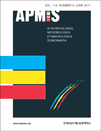Evaluation of disk diffusion methods to detect low-level β-lactamase-negative ampicillin-resistant Haemophilus influenzae
Abstract
Nørskov-Lauritsen N, Ridderberg W, Erikstrup LT, Fuursted K. Evaluation of disk diffusion methods to detect low-level β-lactamase-negative ampicillin-resistant Haemophilus influenzae. APMIS 2011; 119: 385–92.
We evaluated the efficacy of disk diffusion methods for detection of low-level β-lactamase-negative ampicillin-resistant (low-BLNAR) Haemophilus influenzae. Four hundred and seventy unselected, recent clinical isolates were tested with ampicillin (10 μg), cefaclor (30 μg) and cefuroxime (30 μg) on iso-Sensitest agar enriched with nicotinamide adenine dinucleotide (NAD) and horse blood [ST agar; Swedish Reference Group for Antibiotics (SRGA) guidelines], and on chocolate agar (in-house guidelines). Selected isolates (n = 147) were subjected to partial sequencing of the ftsI gene. Forty-seven strains (10.0%) were genotypically identified as low-BLNAR, which was confirmed by determination of minimal inhibitory concentration (MIC) using microbroth dilution method: only low level resistance to ampicillin was detected [MIC ≤1 μg/mL; MIC50 = 0.5 μg/mL, implying susceptibility by Clinical and Laboratory Standards Institute (CLSI) and European Committee on Antibiotic Susceptibility Testing (EUCAST) interpretative criteria]. The MIC of cefuroxime varied between 1 and 4 μg/mL (MIC50 = 2 μg/mL), indicating susceptibility to cefuroxime by CLSI but not by EUCAST guidelines. Disk diffusion methods were able to discriminate low-BLNAR H. influenzae from the wild-type population with sensitivities ranging from 87% to 98% and specificities from 96% to 99%. Cefaclor was found to be superior to cefuroxime and ampicillin. Cefaclor zone diameter breakpoints of 30/29 and 23/22 mm are suggested for ST agar and chocolate agar, respectively.




